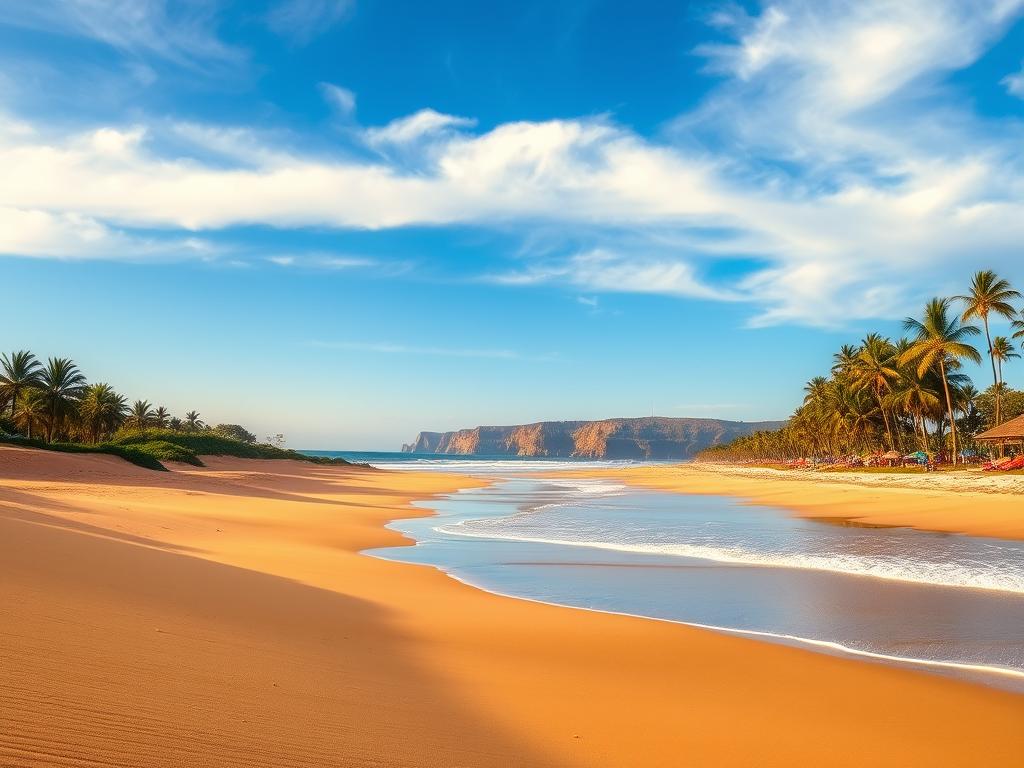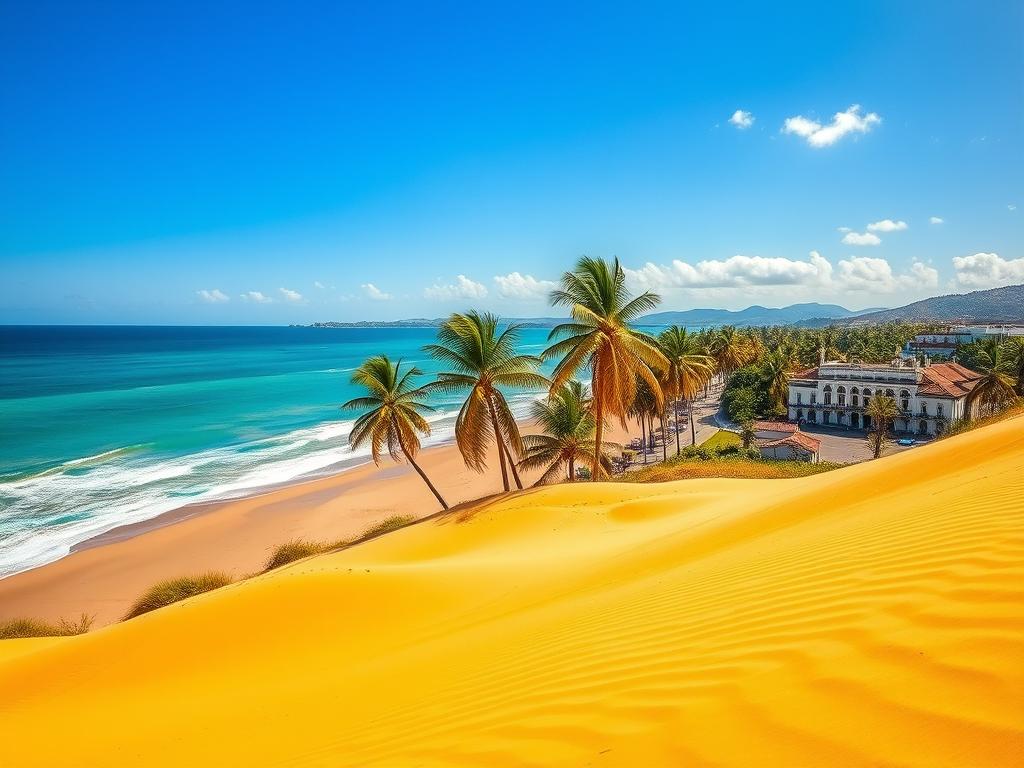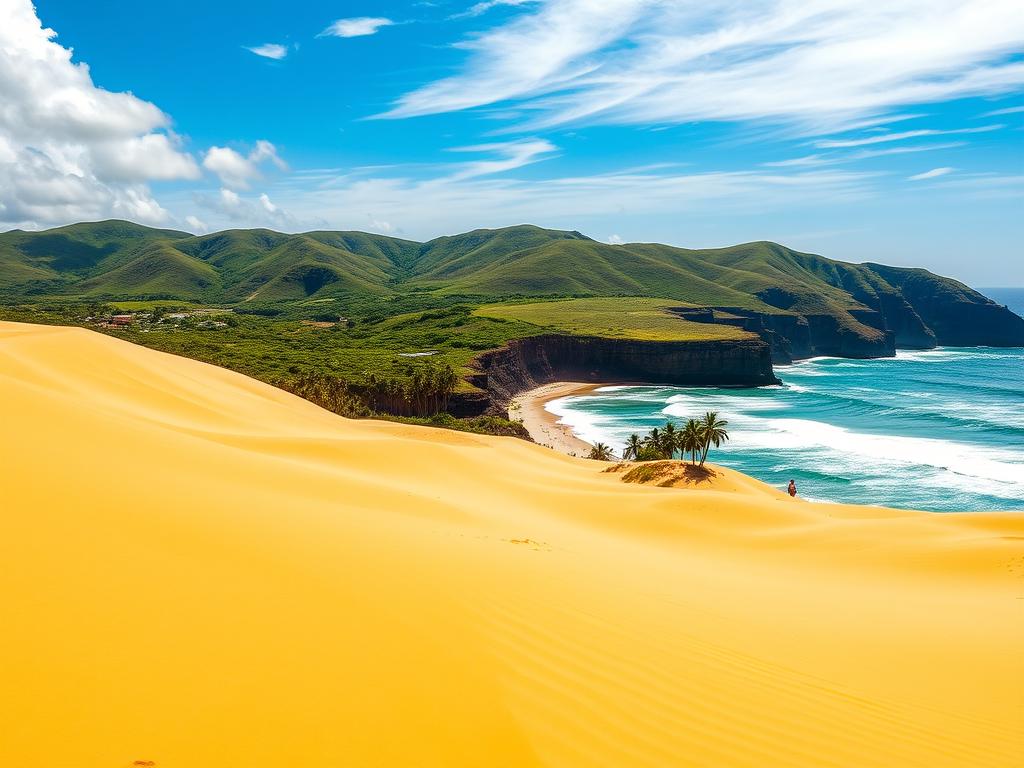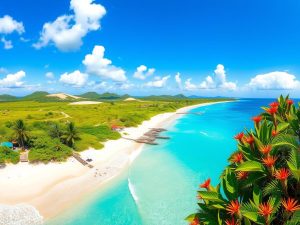
Natal is a coastal city in northeastern Brazil, known for its sun, sand, and culture. It’s called the “Capital of Sun and Dunes.” This city attracts visitors worldwide, especially during Christmas and summer.
Natal is famous for its sand dunes, beautiful beaches, and vibrant culture. It’s a top beach spot in Brazil.
Natal is on the left bank of the Potengi River. It started with the Potiguares Indians and grew into a bustling city. Its sunny weather all year makes it the “City of the Sun.” Visitors can enjoy its natural beauty and rich culture.
Introduction to the City of Natal
Nestled along the northeastern coast of Brazil, the captivating city of Natal is the capital of Rio Grande do Norte. Known as the “City of Sun and Dunes,” it has a rich history. It was founded on Christmas Day 1599.
Founded on Christmas Day
The story of Natal’s founding is unique. On December 25, 1599, the Portuguese started a settlement here. They named it Cidade do Natal, or “City of Christmas.” This date has made the city closely tied to Christmas.
Known as the City of Sun and Dunes
With a population of around 800,000, Natal is famous for its natural beauty. It has stunning sand dunes and breathtaking beaches. Located in northeast Brazil, it enjoys lots of sunshine, over 300 days a year. This makes it the “City of Sun and Dunes.”

“Natal, the capital of Rio Grande do Norte, is a captivating coastal city that seamlessly blends its rich history with a stunning natural landscape.”
Natal’s Stunning Natural Landscapes
Natal, the capital of Rio Grande do Norte, is famous for its stunning natural beauty. It attracts visitors from all over the world. The city’s heart is filled with magnificent sand dunes and beautiful beaches, making it truly unique.
Magnificent Sand Dunes
The sand dunes in Natal are a big attraction for those looking for adventure. These golden hills of sand are perfect for sandboarding and buggy rides. They let travelers dive into the area’s natural beauty.
- The Genipabu dunes, just 25 km north of the city center, are great for dune buggy rides and sandboarding.
- The Barra de Maxaranguape Beach, about 45 km from Natal, has impressive sand dunes for exploring on foot or by buggy.
- The Búzios Beach, 20 km from Natal, is famous for its stunning sand dunes and views of the landscape.
Breathtaking Beaches
Natal’s beaches are a showcase of the city’s beauty. They offer turquoise waters and pristine coastlines. Places like Ponta Negra Beach and Pirangi Beach are must-sees for travelers.
- Ponta Negra Beach, known as Natal’s “Copacabana,” is a 4-kilometer stretch of stunning waterfront. It’s famous for its lively atmosphere and views.
- Pirangi Beach, 20 km south of the city center, is quieter and more secluded. It’s split by the Pirangi River into two parts.
- Praia do Forte, just north of Natal, is known for its amazing scuba diving. It’s a top spot for underwater explorers.

“Natal is a true gem of northeast Brazil, offering a captivating blend of natural wonders that leave a lasting impression on all who visit.”
Exploring the Dunes of Genipabu
One of the top spots in Natal is the Genipabu dunes, just north of the city. These huge sand dunes offer exciting buggy rides. They let visitors get up close to the unique landscape. The Genipabu Lagoon nearby is a calm spot, with dark waters that stand out against the dunes.
Visiting the dunes and lagoon of Genipabu is a highlight for many. It’s a mix of outdoor activities and adventure tourism.
Thrilling Buggy Rides
The Genipabu dunes are perfect for those who love a thrill. They offer buggy rides through the changing sand. These off-road vehicles take you through the dunes, giving you a unique view of the area.
As you ride, you’ll feel the wind and see amazing views. It’s an experience you won’t forget.
Genipabu Lagoon’s Tranquil Waters
The Genipabu Lagoon is a calm place compared to the dunes. Its dark waters are peaceful, inviting visitors to relax. It’s a great place to unwind and enjoy nature.
The lagoon’s calm is a nice contrast to the buggy rides. It makes your visit to the Genipabu dunes even better.
“Exploring the Genipabu dunes and lagoon is a must-do activity for visitors to Natal. The contrast between the adrenaline-filled buggy rides and the serene tranquility of the lagoon makes for an unforgettable adventure.”
Ponta Negra: Natal’s Iconic Beach
Ponta Negra is the top beach in Natal. It stretches almost 4 kilometers along the coast. Both tourists and locals love it for its beauty and fun vibe.
The Morro do Careca, a 120-meter-high white sand dune, is its standout feature. It drops right into the sea, creating a stunning view.
Even though climbing the Morro do Careca is not allowed, you can still see its beauty from the beach. Its unique shape and white sands make it a famous landmark in Natal.
Ponta Negra has lots to do besides the Morro do Careca. The beach is full of bars, restaurants, and shops. It’s lively, especially at night.
You can also check out the Genipabu dunes and lagoon. Or, try exciting buggy rides across the sand.
Looking for a calm day by the sea or an adventure? Ponta Negra Beach is the place to be. It shows what makes Natal so special.
Discovering Natal: The Capital of Sun and Dunes
Natal, the capital of Rio Grande do Norte, is a captivating coastal city in Brazil. It offers a unique blend of stunning natural landscapes, rich history, and vibrant culture. From its magnificent sand dunes and breathtaking beaches to its historical landmarks and outdoor adventures, Natal truly lives up to its moniker as the “Capital of Sun and Dunes.”
Founded on Christmas Day, Natal has a long and fascinating history. By the end of the 19th century, the city’s population had reached approximately 16,000. The city experienced accelerated growth in 1922 when urbanization efforts began, and it played an important role as a North American Navy and Air Base during World War II.
Today, Natal is a thriving beach destination, attracting thousands of tourists each year. The city’s population has grown to an estimated 751,300 in 2022, making it the 24th largest city in Brazil. With a high population density of 4,500 inhabitants per square kilometer, Natal is a vibrant and lively coastal city.
The city’s natural landscapes are truly breathtaking, with its magnificent sand dunes, pristine beaches, and lush vegetation. The Via Costeira, a 10 km long coastal road along the dunes, was established in the 1980s, offering visitors stunning views of the coastline. Natal’s tourist activities, including its thrilling buggy rides and tranquil lagoon, continue to attract visitors from around the world.
| Key Natal Statistics | Value |
|---|---|
| Total Population (2022) | 751,300 |
| Population Density | 4,500 inhabitants/sq km |
| Metropolitan Area Population | 1.52 million |
| Racial Makeup (Pardo/Multiracial) | 46.6% |
| City Area | 167.3 sq km |
| Average Temperature | 27°C (80.6°F) |
| Annual Rainfall | 1,690 mm (67 in) |
| Human Development Index (HDI) | 0.763 (high) |
Natal’s captivating natural landscapes, rich history, and vibrant culture make it a must-visit destination for anyone exploring the Brazil coast. From the stunning sand dunes to the bustling beach life, Natal truly is the capital of sun and dunes.
“Natal is a true gem of the Brazil coast, offering visitors a unique and unforgettable experience.”
Historical and Cultural Attractions
Natal, the capital of Rio Grande do Norte, is full of historical and cultural spots. One key place is the Forte dos Reis Magos. It’s a 16th-century Portuguese fort by the Potengi River.
This fort, built in 1598, shows the area’s Portuguese past. It’s a key part of Natal’s culture today. Visitors can see the fort’s walls, enjoy views, and learn about its history.
Natal also has other historical and cultural sites. The Câmara Cascudo Museum has over 160,000 items. It helps visitors understand the area’s history and traditions. The Popular Culture Museum Djalma Maranhão focuses on Rio Grande do Norte’s unique culture.
For those interested in Natal historical attractions, Portuguese colonial history, or cultural heritage, there’s plenty to see. This vibrant Brazilian city offers a deep dive into its past and present.
Forte dos Reis Magos
The Forte dos Reis Magos is a key part of Natal’s Portuguese colonial history. Built in 1598, it’s a 16th-century fortress by the Potengi River. It’s a chance to explore Natal’s past and appreciate its cultural heritage.
The Portuguese built the fort in 1598. It was important for Natal’s growth, as a military base and symbol of colonial history. Today, visitors can see its walls, enjoy views, and learn about its role in the city’s history.
If you love history, culture, or just beautiful architecture and views, the Forte dos Reis Magos is a must-see. It’s a highlight of Natal historical attractions and its cultural heritage.
Outdoor Adventures in Natal
Natal, the capital of Rio Grande do Norte, is a top spot for adventure. It offers many outdoor activities in its beautiful landscapes. Sandboarding on the dunes and snorkeling at Parrachos de Maracajaú are two favorites.
Sandboarding on the Dunes
Natal’s sand dunes are perfect for sandboarding. You can speed down the slopes, feeling the thrill of the ride. With over 3,000 sunny hours a year, Natal is great for this activity.
Snorkeling at Parrachos de Maracajaú
The Parrachos de Maracajaú is 60 km north of Natal. It’s known as the “Brazilian Caribbean” for its clear waters and marine life. Snorkeling here lets you see vibrant corals and tropical fish. A short boat ride gets you to the best spots.
Natal offers both the excitement of sandboarding and the calm of snorkeling. It’s a great way to see the natural beauty of this coastal city.
Culinary Delights of Natal
Natal, the capital of Rio Grande do Norte, is a food lover’s dream. It offers a mix of Natal cuisine and Brazilian northeast flavors. You can enjoy everything from fresh seafood to traditional local food dishes.
The city’s seafood is a highlight. Fresh shrimp, lobster, and more come from the Atlantic Ocean. Restaurants along Ponta Negra beach serve up moqueca and arrumadinho, among other dishes.
| Natal Cuisine Highlights | Must-Try Dishes |
|---|---|
| Fresh Seafood |
|
| Traditional Local Cuisine |
|
Natal also offers traditional local food dishes. Try cuscuz, tapioca, acarajé, and queijo de coalho. These dishes show off the region’s rich culture and unique tastes.
Looking for fresh seafood or wanting to try Natal cuisine and Brazilian northeast dishes? Natal’s food scene will impress you. It will make you want to explore more of the area’s food.
Nightlife and Entertainment
Natal’s nightlife buzzes around Ponta Negra beachfront. Bars, restaurants, and entertainment venues light up after dark. This lively spot draws both locals and tourists with its music, food, and social vibes.
Vibrant Bars and Restaurants in Ponta Negra
On Ponta Negra promenade, you can enjoy fresh seafood and live tunes. The area has something for everyone, from casual beach bars to fancy restaurants. It’s perfect for any night out.
- Enjoy the lively atmosphere and live music at the popular Boate dos Calangos nightclub, open every Friday, Saturday, Sunday, and holidays.
- Experience the energy of Anima Pipa, another well-received nightclub in the area.
- Savor the local cuisine and vibrant ambiance at the approximately 50 restaurants in Ponta Negra, featuring international flavors and fresh seafood.
Ponta Negra offers a relaxed or lively night out. Its lively vibe and varied entertainment make it a top spot for Natal nightlife.
“Ponta Negra is the heart of Natal’s nightlife, where the city’s energy and love for entertainment come alive.” – Local Resident
Eco-Tourism in Natal
Natal, the capital of Rio Grande do Norte, is known for its eco-tourism and environmental efforts. The Parque das Dunas is a key part of this, being the city’s first conservation unit. It shows Natal’s commitment to sustainable tourism and preserving its natural beauty.
Parque das Dunas
The Parque das Dunas is a protected coastal area within the Brazilian Atlantic Forest Biosphere Reserve. It offers visitors a chance to see stunning sand dunes and learn about local plants and animals. This park focuses on environmental conservation and nature preservation, making it a unique spot for Natal eco-tourism.
Established in 1977, the Parque das Dunas is a symbol of Natal’s dedication to sustainable development. It’s a key eco-tourism spot, offering a peaceful break from the city. Here, visitors can experience the area’s natural beauty and ecological significance.
“The Parque das Dunas is a true oasis in the heart of Natal, showcasing the city’s dedication to preserving its natural heritage for generations to come.”
Natal keeps leading in eco-tourism and sustainable tourism through places like the Parque das Dunas. It’s a top spot for those wanting to explore the natural world’s wonders.
Getting Around Natal
Navigating Natal is easy with many transportation options. The city is small and well-connected. You can use public buses, taxis, or rent cars.
For adventure, try traditional buggies. They let you explore sand dunes and beaches. It’s a fun way to see Natal’s beauty.
The ferry service is another great option. It crosses the Potengi River. You’ll see the city from a different view and learn about local culture.
Exploring Natal by Public Transportation
The public bus system is cheap and efficient. It covers many areas, including landmarks and shopping spots. Use the bus route maps and schedules to plan your trips.
Navigating Natal by Taxi
Taxis are convenient and direct. They’re easy to find and fares are fair. They’re good for short trips or exploring different areas.
Renting a Car in Natal
Renting a car gives you freedom to explore. Many car rental companies offer various vehicles. It’s great for finding hidden spots and making your trip memorable.
Natal’s good infrastructure and many transportation options make it easy to get around. You can enjoy the city’s beauty and culture without hassle.
Conclusion
Natal, known as the “Capital of Sun and Dunes,” is a stunning coastal spot in northeastern Brazil. It combines beautiful natural views, a rich history, and a lively culture. Visitors can enjoy its amazing sand dunes, beautiful beaches, historical sites, and outdoor fun.
Natal has something for everyone, whether you want adventure, cultural experiences, or just to relax. Its long coastline, varied wildlife, and natural wonders like the Maior Cajueiro do Mundo and Parque das Dunas are unforgettable. It’s a top choice for those who love the beauty of sun and dunes.
Natal’s warm weather, exciting nightlife, and deep cultural roots attract visitors all year. You can explore the iconic Natal Metropolitan Cathedral or enjoy the vibrant Natal Carnival. This city is a unique gem in Brazil, full of experiences waiting to be discovered.

